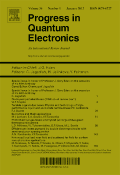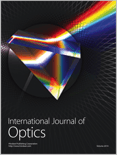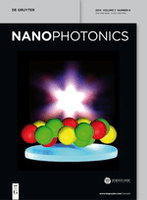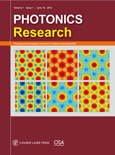
Progress in Electromagnetics Research-PIER
Scope & Guideline
Elevating Standards in Research and Innovation
Introduction
Aims and Scopes
- Advanced Electromagnetic Materials and Devices:
The journal emphasizes the development and application of novel materials such as metamaterials and plasmonic materials, which enable new functionalities in electromagnetic devices ranging from antennas to sensors. - Computational Electromagnetics:
A significant portion of the research involves computational techniques, including numerical simulations and machine learning approaches, to solve complex electromagnetic problems and optimize device performance. - Quantum and Microwave Technologies:
PIER explores the intersection of quantum mechanics and microwave engineering, focusing on applications such as quantum radar and communication systems, highlighting innovations in quantum sources and detectors. - Wireless Communications and Sensing:
Research in this area includes novel antenna designs, wireless power transfer systems, and integrated communications, aiming to enhance the efficiency and capabilities of modern wireless technologies. - Biophysics and Biomedical Applications:
The journal covers applications of electromagnetics in biophysics and healthcare, including non-invasive sensing techniques and imaging technologies that leverage electromagnetic principles for medical diagnostics. - Optical and Photonic Devices:
PIER also focuses on advancements in optical devices, including photonic circuits and integrated optics, with applications in imaging, sensing, and telecommunications.
Trending and Emerging
- Machine Learning and AI in Electromagnetics:
There is a growing emphasis on the use of machine learning and artificial intelligence techniques for optimizing designs and enhancing performance in electromagnetics, reflecting a broader trend in engineering and science. - Metamaterials and Metasurfaces:
Research on metamaterials and metasurfaces is rapidly increasing, focusing on their unique capabilities for manipulating electromagnetic waves, which is crucial for next-generation devices and applications. - Quantum Electromagnetics:
The exploration of quantum principles in electromagnetics is a burgeoning area, particularly in applications to quantum communication and radar technologies, indicating a significant shift towards quantum-enhanced systems. - Integrated Photonics and Nanotechnology:
Emerging themes in integrated photonic circuits and their applications in telecommunications and sensing reflect a trend towards miniaturization and integration in electromagnetic systems. - Biophotonic and Biomedical Applications:
Research aimed at applying electromagnetic techniques in biomedical fields, such as sensing and imaging technologies for health diagnostics, is gaining traction, highlighting the journal's commitment to addressing real-world challenges.
Declining or Waning
- Traditional Antenna Technologies:
Research focusing on conventional antenna designs has seen a decline, as newer technologies such as reconfigurable antennas and advanced materials take precedence in the literature. - Classical Electromagnetic Theory Applications:
There has been a noticeable decrease in papers relying solely on classical electromagnetic theory without integration of modern computational or experimental techniques, suggesting a shift towards more innovative methodologies. - Static Electromagnetic Applications:
Topics centered around static or low-frequency electromagnetic applications are becoming less frequent, as the journal increasingly prioritizes high-frequency and dynamic applications in its publications.
Similar Journals

Progress in Electromagnetics Research Letters
Innovating Tomorrow's Technologies TodayProgress in Electromagnetics Research Letters, published by EMW PUBLISHING, is a vital peer-reviewed journal dedicated to the fields of electronics, optics, and magnetics. With an emphasis on innovative research and technological advancements, this journal has established itself in the academic community since its inception in 2008, and it will continue to publish valuable findings through 2024. The journal holds a respectable Q3 ranking in Electronic, Optical and Magnetic Materials, positioning it among the noteworthy contributions to the field, despite its percentile standing in Scopus. Researchers and professionals benefit from its commitment to disseminating high-quality research without the constraints of open access, ensuring that cutting-edge ideas reach a targeted audience. By fostering knowledge exchange, Progress in Electromagnetics Research Letters is poised to influence current and future advancements in electromagnetic technologies, making it a trusted platform for scholars and practitioners alike.

eLight
Illuminating the Future of Atomic and Molecular PhysicseLight is a leading academic journal published by SPRINGER NATURE, dedicated to the dynamic field of Atomic and Molecular Physics, as well as Electronic, Optical, and Magnetic Materials. Launched in 2021, the journal has quickly established itself as a reputable source of cutting-edge research, evidenced by its impressive Q1 quartile rankings in both categories for 2023, alongside remarkable Scopus rankings that place it in the top 2% of its fields. With a commitment to advancing knowledge and fostering innovation, eLight invites contributions from researchers, professionals, and students who are passionate about exploring new frontiers in these critical areas of study. Hitting a critical intersection of physics and materials science, the journal provides an open forum for the dissemination of experimental findings, theoretical studies, and application-based research, ensuring accessibility to vital discoveries that drive progress in technology and academia. Located in Singapore, eLight is poised to make significant contributions to the scientific community until at least 2024, and beyond.

Journal of Electromagnetic Engineering and Science
Connecting Theory and Practice in Electromagnetic ScienceThe Journal of Electromagnetic Engineering and Science (ISSN: 2671-7255, E-ISSN: 2671-7263) is a premier Open Access journal published by the Korean Institute of Electromagnetic Engineering & Science. Since its establishment in 2001, it has been dedicated to advancing knowledge in the fields of Electrical Engineering, Electromagnetic Theory, and Communications, making significant contributions to both academia and industry. The journal holds an impressive Q2 quartile ranking in notable categories such as Computer Networks and Communications and Electrical and Electronic Engineering as of 2023, reflecting its robust scientific impact and reputation. It is indexed in Scopus, with commendable rankings in multiple fields, enhancing its visibility and reach among researchers. The journal's open-access model ensures that cutting-edge research is accessible to a global audience, fostering collaboration and innovation. Researchers, professionals, and students in the domain are encouraged to contribute and engage with high-quality articles that cover the latest advancements and trends in electromagnetic engineering and associated sciences.

PROGRESS IN QUANTUM ELECTRONICS
Unveiling Breakthroughs in Quantum ElectronicsPROGRESS IN QUANTUM ELECTRONICS, published by PERGAMON-ELSEVIER SCIENCE LTD, is a premier international journal that serves as a critical forum for the dissemination of high-quality research in the fields of atomic and molecular physics, electrical engineering, and materials science. With its esteemed Q1 category ranking in several disciplines, including Atomic and Molecular Physics, Electrical and Electronic Engineering, and Electronic, Optical and Magnetic Materials, this journal commands a high impact factor and is recognized for its rigorous peer-review process. Established in 1969 and evolving through various phases, the journal currently compiles cutting-edge research that drives advancements in quantum technologies. Researchers, professionals, and students alike are invited to explore a wealth of knowledge and stay updated on pioneering developments in quantum electronics, enhancing their understanding and contributing to the progression of this dynamic field.

ELECTRONICS LETTERS
Transforming Research into Real-World Applications.ELECTRONICS LETTERS, published by WILEY, is a leading peer-reviewed journal dedicated to the field of Electrical and Electronic Engineering. With a rich history dating back to 1965, this journal serves as a prominent platform for disseminating novel research and innovations in electronics, covering topics such as circuit design, telecommunications, and signal processing. In 2021, the journal transitioned to an Open Access format, ensuring that cutting-edge research is freely accessible to a global audience, thereby enhancing its impact and outreach. The journal currently holds a Q3 quartile ranking in its category, reflecting its solid position among its peers, and ranks #451 out of 797 in Scopus for Electrical and Electronic Engineering, placing it within the 43rd percentile. ELECTRONICS LETTERS is essential for researchers, professionals, and students looking to stay abreast of the latest developments and contribute to advancements in the field, fostering collaboration and knowledge sharing in a rapidly evolving landscape.

International Journal of Optics
Connecting Science and Application in OpticsWelcome to the International Journal of Optics, a distinguished publication dedicated to advancing the field of optics and its interdisciplinary applications. Published by HINDAWI LTD, this open-access journal has been pivotal in fostering knowledge since its inception in 2009. With a robust focus on atomic and molecular physics as well as electronic, optical, and magnetic materials, the journal has carved its niche within Q3 quartile rankings in these categories for 2023, signifying its growing impact and relevance in the scientific community. Researchers and professionals will find a rich repository of innovative and cutting-edge research articles that not only address fundamental aspects of optics but also explore practical applications across various domains. The journal's aim is to promote high-quality research dissemination, enhancing collaboration among scientists and ensuring that pivotal findings reach a global audience. Join us in exploring the dynamic world of optics—where your contributions help shape the future of science.

Nanophotonics
Connecting Researchers in the Realm of LightNanophotonics, published by WALTER DE GRUYTER GMBH, is a premier open access journal dedicated to advancing the field of nanophotonics, encompassing cutting-edge research in atomic and molecular physics, optics, biotechnology, and electronic engineering. With a significant impact factor and a notable presence in the top quartile rankings (Q1) across multiple categories, including electrical and electronic engineering, this journal serves as a critical resource for researchers and professionals aiming to explore the latest developments in the manipulation of light at the nanoscale. Since its inception in 2012, Nanophotonics has been an influential platform for disseminating innovative ideas and breakthroughs, offering unrestricted access to its content, thus fostering a collaborative environment conducive to scientific discovery. Located in Berlin, Germany, and with a commitment to promoting the highest standard of scholarly excellence, Nanophotonics continues to shape the future of optical materials and technology, inviting contributions from both established experts and emerging scholars.

Photonics Research
Empowering Researchers with Open-Access KnowledgePhotonics Research, published by Chinese Laser Press, is a premier international journal that aims to disseminate cutting-edge research and advancements in the field of photonics, encompassing areas such as atomic and molecular physics, optics, and materials science. Since its inception in 2013, this journal has established itself as a vital resource for academics and professionals, reflected in its impressive Q1 rankings in both Atomic and Molecular Physics, and Optics (15/224) and Electronic, Optical and Magnetic Materials (26/284) as per Scopus, underscoring its influence within the scientific community. With substantial contributions to the field, Photonics Research continues to foster innovation and collaboration among researchers, serving as an essential platform for the publication of high-quality studies that push the boundaries of knowledge. The journal operates on an open-access model, ensuring that research is readily available to a global audience, thereby enhancing its accessibility and impact. Whether you are a researcher, student, or professional, engaging with this journal offers a significant opportunity to stay at the forefront of photonic technologies and ideas.

MICROWAVE JOURNAL
Fostering Innovation in the World of MicrowavesMicrowave Journal, published by Horizon House Publications Inc, is a well-established platform in the field of Electrical and Electronic Engineering, specifically focusing on the advancements and applications of microwave technology. Since its inception in 1969, the journal has consistently delivered high-quality research, making it an invaluable resource for professionals, researchers, and students alike. Despite its Q4 ranking in Scopus for 2023, the journal plays a crucial role in disseminating knowledge and fostering innovation within its niche, showcasing developments across various areas including microwave systems, components, and applications. Although it does not offer Open Access, the journal’s comprehensive insights and peer-reviewed articles are essential for anyone looking to deepen their understanding of microwave engineering. By maintaining a rigorous editorial standard, Microwave Journal continues to shape the discussion and evolution of microwave technology.

Communications Physics
Advancing the frontiers of Physics and Astronomy.Communications Physics is a premier open access journal published by Nature Portfolio, dedicated to disseminating high-quality research in the field of Physics and Astronomy. Since its inception in 2018, the journal has rapidly established itself as a vital platform for innovative scientific communication, boasting an impressive Impact Factor and achieving Q1 status in the 2023 category of Physics and Astronomy (miscellaneous). With a Scopus rank of #31 out of 243, placing it within the 87th percentile, Communications Physics attracts a global audience of researchers, professionals, and students eager to engage with cutting-edge findings. The journal supports open access, ensuring that research is freely available to the public, which enhances its visibility and encourages broader discussions within the scientific community. Located in Berlin, Germany, Communications Physics aims to bridge the gap between various disciplines within physics, fostering interdisciplinary collaboration and inspiring future research endeavors.